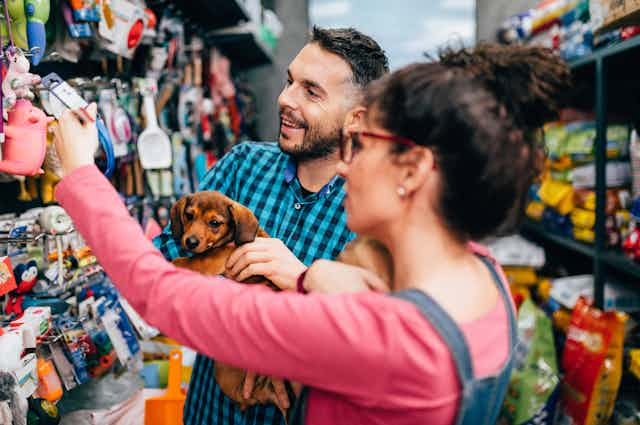Pandemic pets have taken the world by storm. At least 3.2 million households reportedly acquired a pet during the first year of COVID. Young people made up the majority of new owners, with more than half of the new pet owners aged between 16 and 34.
Online shopping with your pooch curled up at your feet is one thing, but would you bring your pet to a store? Retailers hoping to lure young people back to bricks-and-mortar shops should consider letting them bring their animal companions.
British homeware chain Wilko announced that customers may now shop inside 248 of their stores with their animal companions. Pets are allowed in all areas of the stores except for food aisles – a sensible compromise.
But is Wilko barking up the wrong tree? Some unhappy shoppers have raised concerns about hygiene, phobias and badly-behaved pets. While these are legitimate concerns, I would argue they are outweighed by the potential emotional, experiential and commercial benefits of allowing people to shop with their pooches.

Working to make a difference in the world but struggling to save for a home. Trying to live sustainably while dealing with mental health issues. For those of us in our twenties and thirties, these are the kinds of problems we deal with every day. This article is part of Quarter Life, a series that explores those issues and comes up with solutions.
More articles:
Body image issues affect close to 40% of men – but many don’t get the support they need
News of war can impact your mental health — here’s how to cope
How your colleagues affect your home life and vice versa
Research shows that social benefit is often identified as a key motivation of retail shopping. Its importance can be explained with Maslow’s hierarchy of needs, a theory from psychology that explains the connection between human needs and desires. Social shopping may fulfil some people’s need for love and belonging, or for esteem (for example, by being seen as part of the in-crowd at popular stores or high-end retailers like Harrods). Our research shows that the social experience of shopping through entertainment activities, is correlated with spending more time and money in shopping malls.
But academic research has focused mainly on socialising with humans – friends, family and store personnel. This definition is increasingly limited, as new forms of interactions are emerging in the retail sector, like between humans and robots.
Reports suggest that young people find online shopping more convenient, effortless and economical. But online shopping does not have the same social benefit as in-person shopping, especially when four-legged friends are taken into consideration. Recognising new forms of social shopping may be one way to bring people back to our high streets.
Read more: COVID-19 is giving us a new appreciation for physical shops
Dogs are our family
In many countries, the definition of “family” is not confined to humans, but also includes pets. With this in mind, is it not unjust to exclude our dogs from family activities like shopping?
Another study indicates that human-pet relationships are no less intimate or intense than human-human relationships. The anxiety or guilt we experience in having to leave our four-legged family behind while going shopping could be alleviated with completely pet-friendly stores, or specific hours when pets are allowed.
Disallowing people from shopping with their pets could even be seen as contributing to consumer vulnerability. This term broadly describes any situation in which a person is unable to engage effectively in a marketplace.
Shoppers do not take time to browse and explore in stores when they are driven by negative emotional states. Shopping in a hurry, knowing one has to get back to their dog or cat at home, can cost stores sale opportunities and lead to shoppers making purchases too quickly and later returning for a refund.

Pet-friendly retail
Allowing dogs and cats into stores could bring further economic benefits to brands. Pet-owners might spend more money buying accessories for their pets (a lucrative industry) or dining at a dog-friendly cafe. Plus, imagine the joy they’ll get from walking around a store with their furry friend and interacting with other animals.
It’s also an opportunity for retailers to trial pet-friendly merchandise, or special events to lure shopper traffic. Research suggests that events provide a source of entertainment to shoppers and in turn promote socialising and exploration at the stores. This leads to shoppers spending more time and more money with retailers.
It would be easy for retailers to mitigate concerns about hygiene, fears and messy pets. They could designate pet-friendly shopping hours, and design creative signs to set shoppers’ expectations: “When your pooch messes up, please clean up”, for example.
As more people welcome pets into their home, it would be a wise strategy for retailers to welcome them too. It could create new opportunities to do business, and encourage shoppers to stretch their legs (and their pets’ legs) on the high street.

